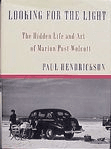
Looking for the Light: The Hidden Life and Art of Marion Post Wolcott
Paul Hendrickson
297 pages, Alfred A. Knopf, 1992
In 1992, while browsing a bookstore in Washington, D.C., I picked up Looking for the Light. On the back cover was a black-and-white photograph, taken in 1933, of a beautiful 23-year-old woman with mesmerizing eyes and a tomboy style of dress. I developed an immediate crush on her, a photographer named Marion Post Wolcott and the subject of the book.
Wolcott was a photographer for the Farm Security Administration during the 1930s, one of several photographers employed by the New Deal agency to document the impact of the Great Depression on the lives of Americans. Wolcott, along with Walker Evans, Dorothea Lange, Gordon Parks, and others, created some of our nation’s most iconic images. But Wolcott never became as famous as some of her contemporaries. That’s because, after taking several hundred thousand photographs over three years, she met a man, put her camera down to start a family, and did not pick that camera up again for almost 50 years.
Paul Hendrickson, the author of Looking for the Light, summarizes Wolcott’s life as “a story about an artist who stopped, who let go of that gifted magical thing inside her until it was too late and the gift was lost. And yet in spite of this fact she was able to make her survival a grace, not just a dour necessity.”
My work, as the founder of Share Our Strength, has focused on hunger and poverty, which is why I’ve always been interested in the era of documentary photography that did so much to bring those issues to public attention. The human drama that Hendrickson conveys about the choices and trade-offs that Wolcott made has universal relevance and was riveting, but what I really took away from the book was a new way to see.
Reading Hendrickson’s richly textured descriptions of Wolcott’s photographs was like watching a magician’s sleight of hand up close and still wondering how he pulled it off. I would look at a photograph, read Hendrickson’s words, and find more than a dozen things my eye had missed. About one photograph of what I saw only as a man sitting in a general store, he writes: “It’s the swirl of that old cane chair, and those lard buckets with their metal bands, and the Compeer snuff cartons behind him, and the way he’s got that five cent cigar cocked, and the popped buttons on his vest … and the flecks of ash on his shiny gabardine.”
About another photograph, of parishioners peeling tomatoes for a 1940 church summer picnic, he writes: “I’ve wondered about the way these good church ladies … are wielding their knives. The knives are too much out in front of them. It doesn’t seem natural. I think they’re afraid some of the juices from those delicious late-summer Big Boys and Beefsteaks are going to splash down their fronts and soak through to their Sunday dresses.”
Looking for the Light taught me to pay attention, that details matter, and that like both Wolcott and her biographer, we all have the power to bear witness. We have the power to go and see and feel and share what we felt. When we do this we often say we’ve been moved. Taken literally that implies starting in one place and ending up in another. It is the basis of all social change.
Bill Shore is the founder and executive director of Share Our Strength, a Washington, D.C.-based nonprofit working to end child hunger in the United States. He serves on the board of directors of the Timberland Company, College Summit, and Venture Philanthropy Partners. From 1978 through 1987, Shore served on the senatorial and presidential campaign staffs of former U.S. Senator Gary Hart. From 1988 to 1991, Shore was chief of staff for former U.S. Senator Robert Kerrey.

